How to Upsell Effectively on Shopify (2026 Guide)

What if you could unlock 20-30% more revenue, without spending a cent more on ads?
That’s the power of upselling done right.
Most Shopify merchants leave money on the table because their upsells are random, irrelevant, or buried at checkout.
But smart stores? They turn every click into a profit multiplier.
With acquisition costs skyrocketing, your best growth lever isn’t more traffic.
It’s more value from the traffic you already have.
Shopify gives you the perfect playground for that, with one-click checkout, post-purchase extensions, and endless customization options.
In this guide, you’ll learn how to upsell effectively on Shopify - step-by-step. You’ll get:
- A proven upsell framework you can plug in today
- Guardrails to protect conversion and brand trust
- Real examples from top Shopify verticals
By the end, you’ll know exactly what to offer, where to show it, and how to scale your average order value without sounding pushy or losing conversions.
Let’s dive in.
Why Upselling Still Wins in 2026
Customer acquisition costs aren’t just rising - they’re exploding.
Between ad platform inflation, privacy changes, and shrinking margins, paying for new customers is harder than ever.
That’s why the smartest Shopify merchants are focusing on maximizing every transaction rather than chasing more clicks.
The Real ROI Shift
When you upsell effectively, you’re increasing revenue from visitors who are already in buying mode.
No extra ad spend. No new traffic. Just smarter timing and relevance.
Think of it this way:
If your store’s average order value (AOV) is $60 and you lift it by 25% through upsells, that’s like increasing revenue by a quarter overnight - with the same number of customers.
The Timing Advantage
Upselling works best when intent is highest:
- On the product page, before they add to cart
- In the cart drawer, during the confirmation moment
- At checkout, when commitment peaks
- And after purchase, when one-click offers convert like crazy
Tools like upsell.com make this easier than ever. You can now insert personalized, one-click upsells immediately after payment - no friction, no risk to the original order.
Bottom line
In 2026, growth belongs to merchants who monetize intent, not just traffic.
If you’re not upselling strategically yet, you’re leaving a double-digit revenue lift on the table.
The Upsell Ladder: A Full-Funnel Upsell Framework
Most merchants treat upsells like random add-ons.
High-performing stores treat them like a system.
That system is what we call The Upsell Ladder (or upsell funnel) - a framework that maps the right offer to the right moment in your Shopify funnel.
It starts light on intent and climbs higher with commitment.
Step 1: Product Page Upsells
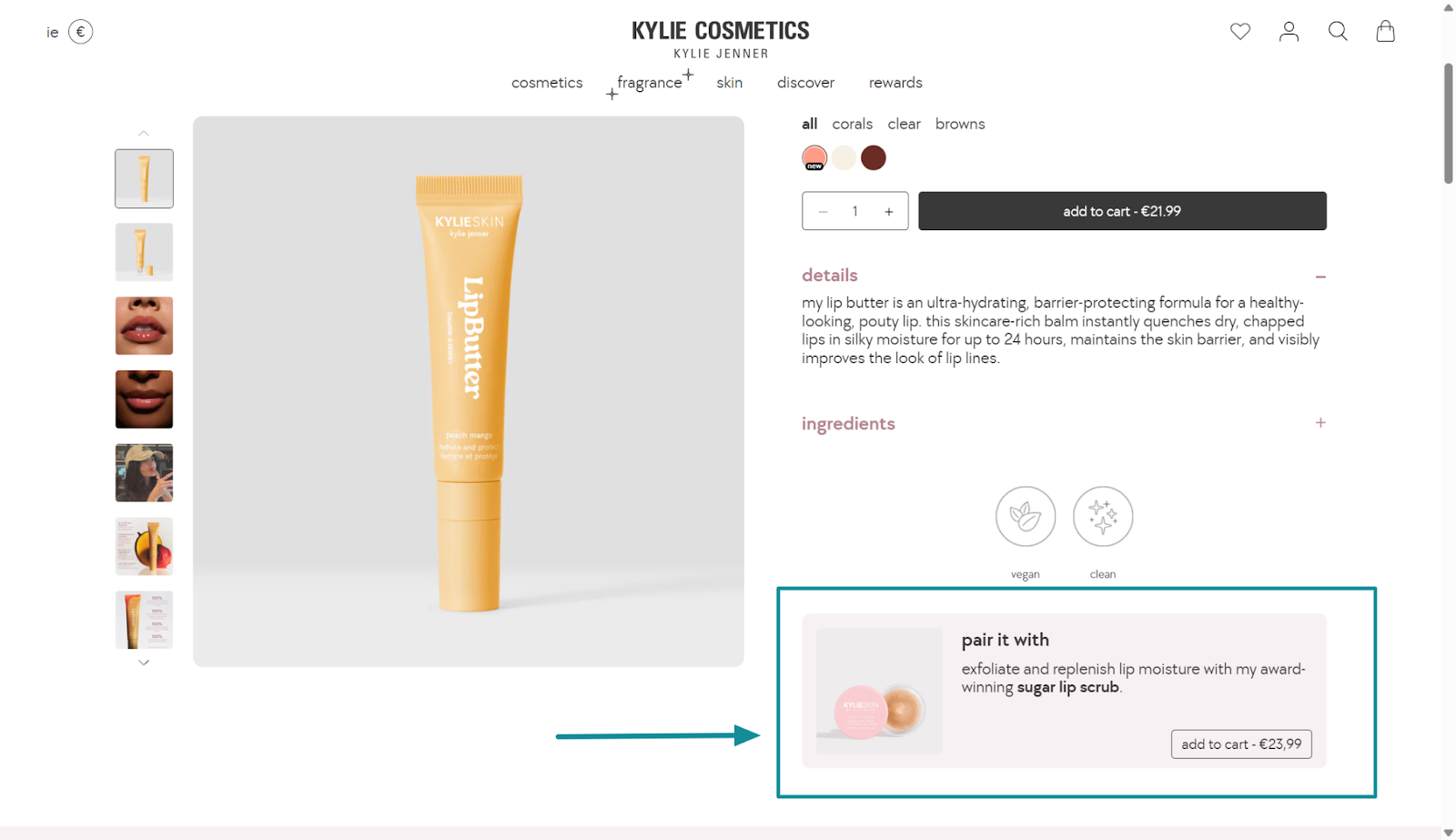
Shoppers here are still exploring, so keep your product page upsells friction-free.
🎯Goal: Increase cart size by helping customers get the best product for their needs
🧠Best plays:
- Premium version (slightly better spec or size)
- Add-on that complements the hero product
- Upgrade bundles (same-category convenience sets)
💡 ReConvert Tip: Use product-specific widgets to show one or two smart add-ons under “You might also like.” Keep choices minimal; Baymard’s research shows fewer options boost decision confidence.
Step 2: Cart Upsells
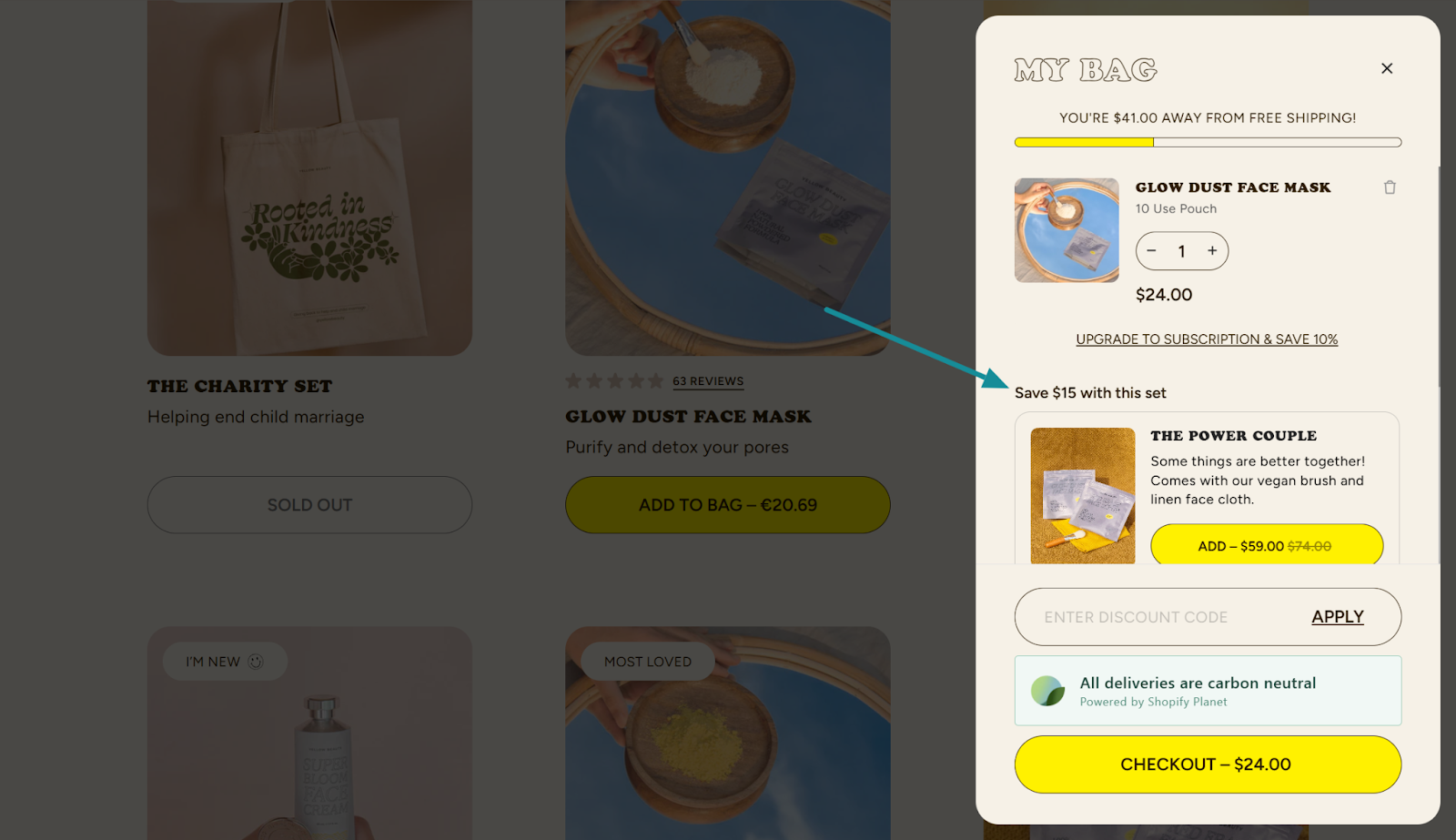
At this stage, shoppers are primed but cautious. They’ve already decided to buy. Use cart upsells combined with a free shipping threshold to nudge AOV higher.
🎯Goal: Present targeted low-ticket cross-sell items with minimal friction
🧠Best plays:
- “Complete your set” add-ons
- Essentials (chargers, refills, accessories)
- Threshold nudges (“Add $10 for free shipping”)
💡 ReConvert Tip: Insert a small, trust-building upsell in the cart drawer — image, benefit line, and one-click add. No pop-ups, no friction.
Step 3: Checkout-Stage Upsells

With checkout upsells, intent is peaking. Don’t distract - enhance.
🎯Goal: Optimize AOV without hurting checkout conversion.
🧠Best plays:
- Premium shipping options
- Protection plans
- Micro product upgrades
💡 ReConvert Tip: Use checkout blocks to surface one clean upsell. Keep copy short and benefit-focused (“Add a 2-year protection plan for peace of mind”).
Step 4: Post-Purchase One-Click Upsells
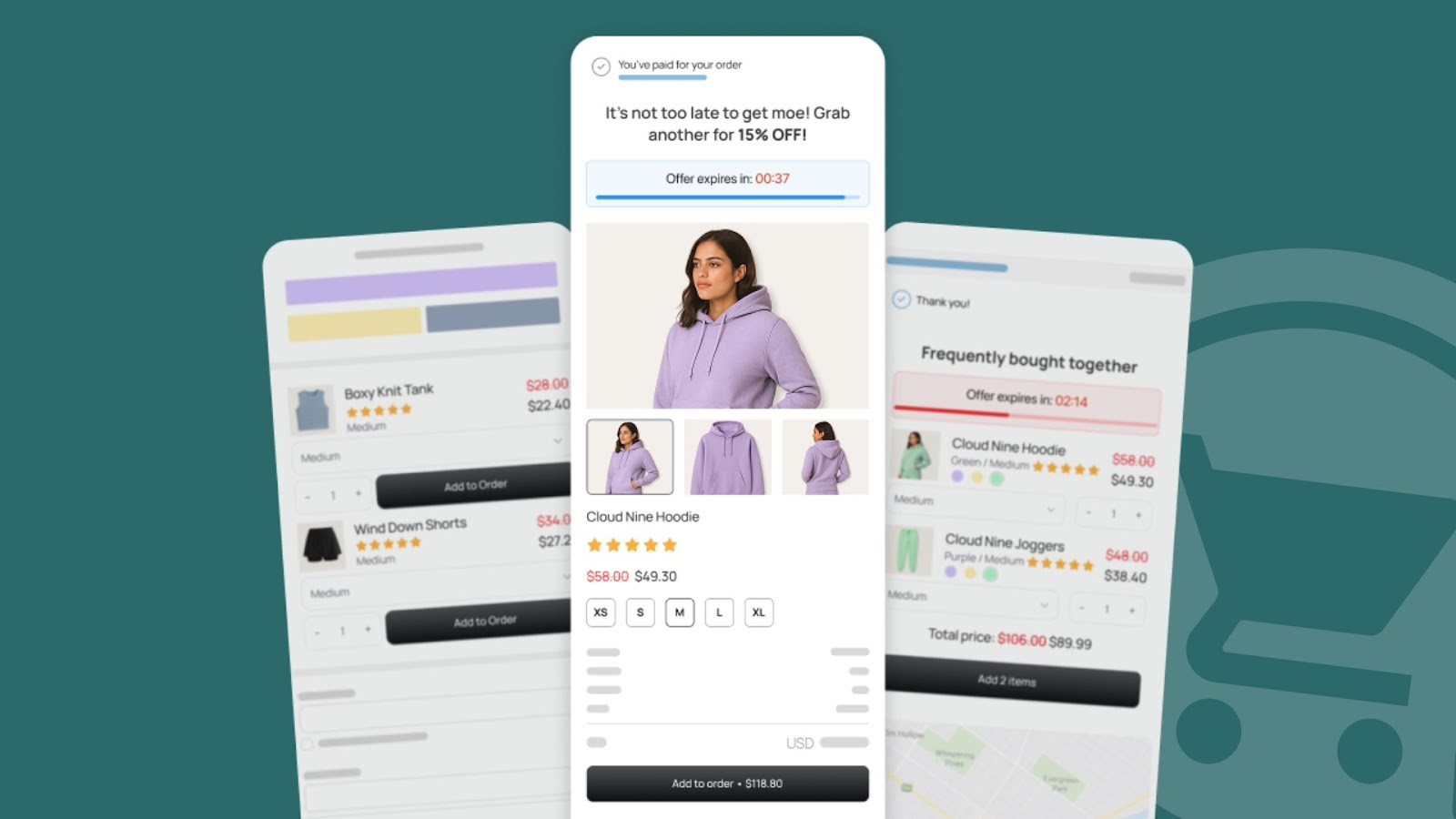
Post-purchase upsells are where the magic happens.
The order is complete, trust is high, and friction is gone; no payment details needed again. Post-purchase upsells convert 2-4x higher than pop-ups because the buyer is already committed.
🎯Goal: Maximize revenue after checkout
🧠Best plays:
- Accessory or complementary product
- Refill pack or extended warranty
- Limited-time exclusive offer
💡 ReConvert Tip: Build a two-step sequence - one primary upsell, then a downsell if declined. Keep the design clean: image, short benefit line, CTA button, subtle “No thanks.”
Step 5: Thank-You Page Upsells

Thank you page upsells are the most underrated step in the funnel. Your customer just bought and is in a “reward mindset.”
🎯Goal: Extend engagement and capture impulse add-ons.
🧠Best plays:
- Discounted “add to existing order” offers
- Loyalty signup incentives
- Replenishment reminders or bundles for repeat use
💡 ReConvert Tip: Transform your thank-you page into a conversion hub. Use dynamic blocks to surface related offers, referrals, or next-order coupons, all without extra load time.
The key here is to think of these as one connected experience, rather than separate tactics.
Each step primes the next, turning first-time buyers into high-value customers before they ever see another ad.
Real Upsell Examples from Top Shopify Verticals
Theory is great, but the best upsell ideas come from the real world.
Every industry has its own sweet spots - those proven offers that feel natural to customers and drive higher average order values without adding friction.
Let’s look at how leading Shopify stores across different verticals put the Upsell Ladder into action.
From beauty brands that boost repeat sales with product bundles to apparel stores that double cart size with outfit pairings, these examples will show exactly how to adapt the framework to your niche.
1. Beauty & Skincare: Lumin
Lumin’s funnel is a masterclass in seamless, systemized upselling. Every step nudges the shopper toward higher value without feeling pushy.
Step 1: Product Page Upsell
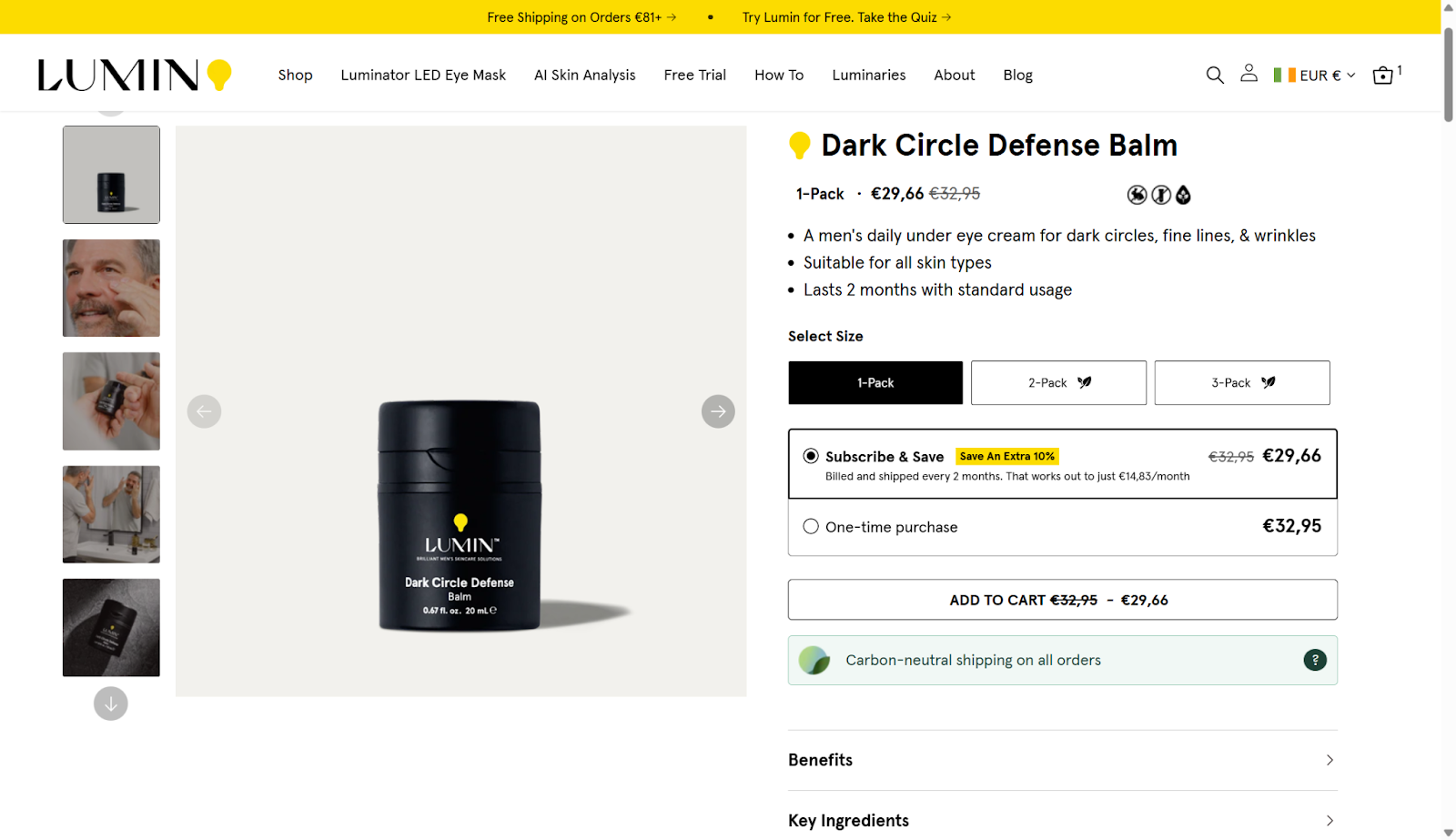
On the Dark Circle Defense Balm product page, shoppers see two clear upgrade paths: a multi-pack (2- or 3-pack) and a “Subscribe & Save” option for 10% off. Both upsells appeal to logic and convenience. The quantity upgrade boosts AOV, while the subscription drives retention and predictable revenue.
Step 2: Cart Drawer Upsell
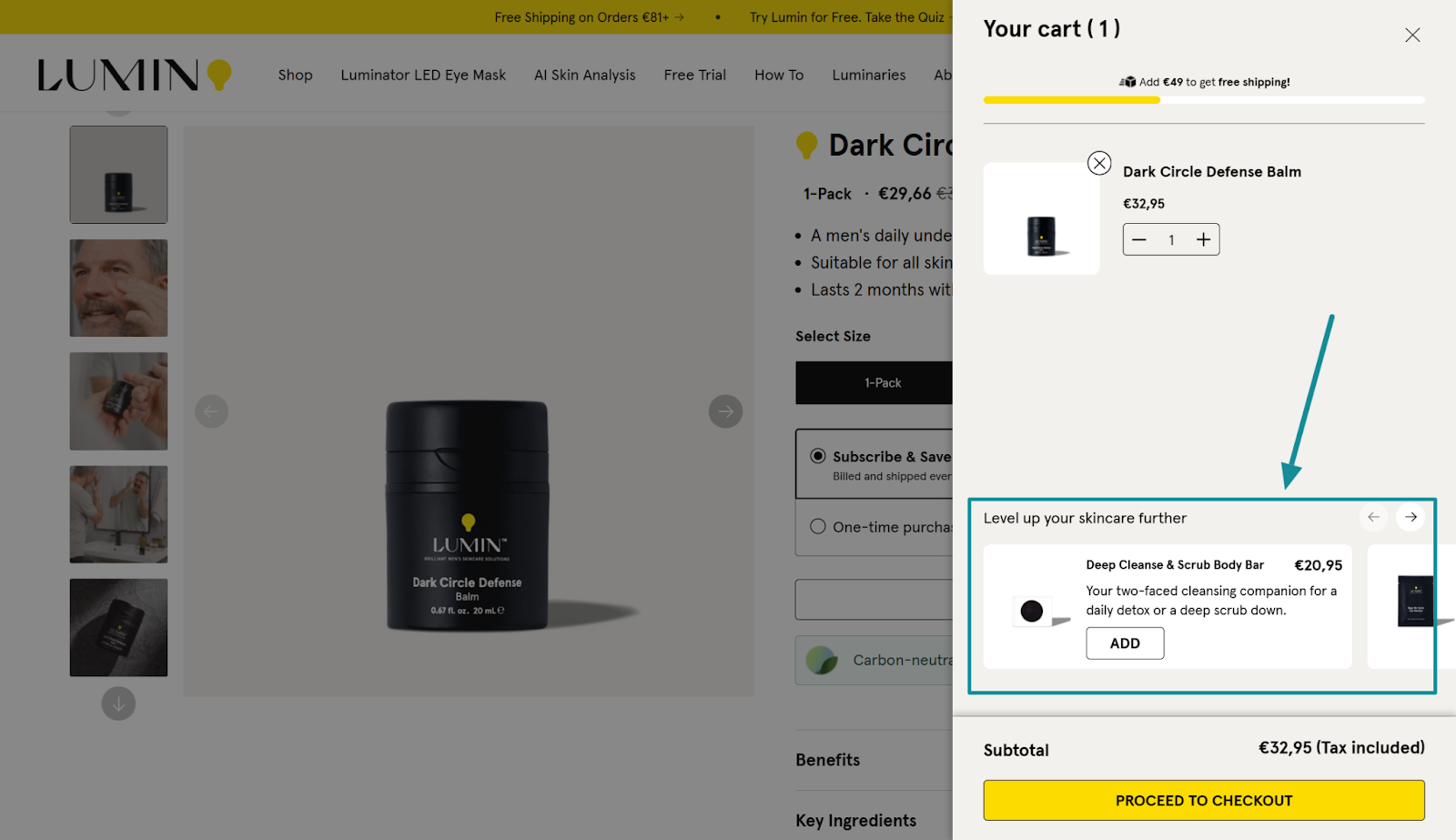
Once the product is added to the cart, the slide-out drawer introduces a complementary item, the Deep Cleanse & Scrub Body Bar, under the line “Level up your skincare further.” It’s a perfect example of an intent-aligned cross-sell: relevant, benefit-focused, and one-click simple.
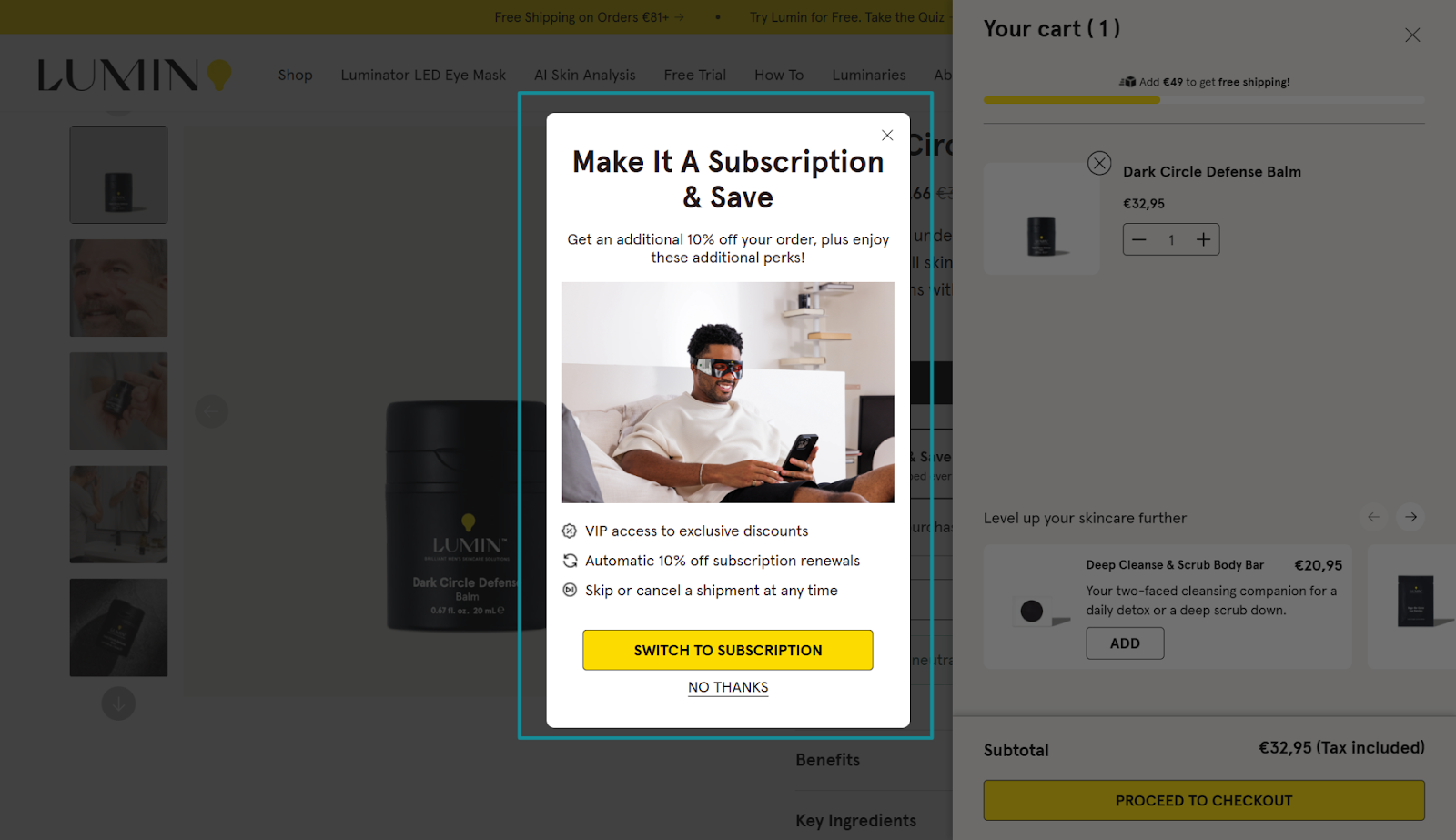
Step 3: Checkout-Stage Upsell
.png)
Lumin adds a Shopify checkout upsell as a soft-sell offer for a Weekly Reboot Face Mask pack, framed as an easy add-on: “The perfect addition to complete your order.” The timing is ideal, the shopper’s already committed, so a low-effort add-on feels like a finishing touch rather than a distraction.
💡 ReConvert Tip: Structure your Shopify funnel like Lumin’s. Start with light-touch product-page upgrades, follow with one well-matched cart cross-sell, then finish with a single checkout add-on. Each step should feel like a continuation of the customer’s journey, not an interruption.
2. Electronics: Nomad Goods
Nomad takes a minimalist approach to upselling that feels perfectly aligned with its premium tech aesthetic. Every offer is contextual, relevant, and visually consistent with the brand.
Step 1: Product Page Upsell
.png)
On the Modern Case product page, shoppers can instantly compare material options — like upgrading from standard leather to Horween Leather for a premium finish. Just below the purchase button, Nomad adds a clear incentive: “Buy a Case, Get 25% Off a Screen Protector.” This is a textbook bundled upsell, pairing a logical accessory that enhances the original purchase.
Step 2: Cart Drawer Upsell
.png)
Once the case is added, the cart drawer reinforces the same theme. A neatly designed “Often Bundled With” section surfaces the matching Screen Protector, pre-discounted and one click away. The offer feels helpful rather than intrusive a finishing touch that anticipates the buyer’s next need without interrupting checkout flow.
💡 ReConvert Tip: When upselling in the electronics vertical, bundle protective or complementary accessories with a clear functional benefit (“Keep your device scratch-free” or “Add fast charging”). Keep design simple and the message consistent across steps - Nomad’s flow shows how clean design can make upsells feel like part of the purchase experience, not a sales tactic.
3. Apparel: Gymshark
Gymshark’s upsell flow is all about outfit completion and motivation, turning each purchase into part of a bigger lifestyle moment. Their approach blends aesthetic merchandising with conversion psychology, a balance few apparel brands nail this well.
Step 1: Product Page Cross-sell
.png)
On the Cosy Luxe Zip Through Hoodie page, shoppers see a “Get the Look” carousel showing matching joggers, tops, and accessories. It’s a contextual upsell that leans on social proof and style synergy rather than discounts. This not only boosts average order value but also increases product discoverability through visual pairing.
Step 2: Browsing Experience Upsells
.png)
On product and collection pages, Gymshark continues the flow with a “You Might Like” section featuring items that “pair perfectly.” This subtle, always-on upsell keeps customers browsing in high intent mode, seamlessly looping them back into discovery and repeat cart adds.
Step 3: Cart Drawer Upsell
.png)
After adding the hoodie to cart, Gymshark’s slide-out drawer prompts with an “Add a Little Extra” section. Here, functional add-ons like the Metal Insulated Straw Bottle and socks are displayed, accompanied by the added motivation of free delivery thresholds (“Add one or more items to get free delivery”). It’s a smart psychological trigger combining utility with urgency.
How to Upsell Effectively: Guardrails to Protect Conversion
Upselling is powerful, but it’s also easy to get wrong. One push too far and you risk turning a high-intent shopper into an abandoned cart.
The best Shopify stores know that effective upsells don’t feel like sales tactics - they feel like personalized recommendations that improve the shopping experience.
Here’s how to maximize revenue without hurting trust or conversion rates.
1. Keep It Relevant
Irrelevant upsells kill momentum. Every offer should make sense in context, think “next logical step,” not “random add-on.”
If a shopper’s buying a men’s skincare product, show complementary items like a moisturizer or face scrub, not a unisex tote bag. Use product tagging or AI-driven recommendation engines to match offers dynamically.
💡 Pro Tip: Map upsells by product category and customer intent. A targeted, helpful suggestion builds trust faster than any discount can.
2. Don’t Overwhelm at Checkout
Checkout is sacred ground. Your customer is in peak decision mode; the wrong pop-up can derail them.
Stick to one clean, benefit-led offer (like a protection plan or small add-on). Avoid stacking upsells, multiple modals, or surprise costs.
💡 Pro Tip: If in doubt, test your upsells against a control group. A 5% lift in AOV isn’t worth a 10% drop in conversion.
3. Use Social Proof, Not Pressure
Upselling works best when it feels inspiring, not manipulative. Swap countdown timers and “Only 3 left!” pop-ups for community-driven trust cues.
Phrases like “Frequently bought together,” “Our customers love this combo,” or “Recommended by 5,000+ shoppers” create confidence and belonging, not stress.
💡 Pro Tip: Highlight real reviews or UGC snippets inside upsell blocks to show authenticity.
4. Make Declines Effortless
One of the fastest ways to lose trust is by trapping customers in upsell loops.
If a shopper says “No thanks,” let them proceed instantly. The goal is to enhance the experience, not hold the order hostage.
💡 Pro Tip: Use soft-dismiss options like a subtle “No thanks, continue to checkout” link. It signals respect and keeps the customer in control.
5. Design for Speed and Mobile
Mobile shoppers dominate Shopify traffic, yet upsells often load slowly or break layouts. That’s a conversion killer.
Prioritize lightweight designs, fast-loading images, and thumb-friendly buttons. Keep CTAs short (“Add for $9”) and ensure your upsell doesn’t push key elements off-screen.
💡 Pro Tip: Use Shopify’s native checkout extensions or lightweight post-purchase apps like ReConvert to avoid performance drag.
Bottom line: Upsells should feel like an upgrade, not an obstacle. When relevance, timing, and respect come first, your store doesn’t just sell more,it earns more loyalty with every click.
How to Upsell Effectively on Shopify: Wrap up
By now, you’ve seen exactly how powerful strategic upselling can be when it’s done right, not as an afterthought, but as part of a well-designed customer journey.
The truth is, Shopify gives you everything you need to turn one-time buyers into long-term customers. But most stores only use a fraction of that potential.
The difference between average and exceptional performance comes down to how you use each moment in the funnel.
Here’s your Upsell Ladder in action:
- Product page: Offer helpful upgrades or bundles that improve the purchase (like Lumin’s multi-pack or Nomad’s screen protector deal).
- Cart drawer: Reinforce intent with low-friction, complementary adds (think Gymshark’s “Add a Little Extra” suggestions).
- Checkout: Keep it clean and contextual, one offer that enhances, not distracts.
- Post-purchase: Capitalize on trust and momentum with one-click offers that feel like a reward.
- Thank-you page: Turn engagement into loyalty through reorders, referral prompts, or future discounts.
Each step builds on the last, turning a simple transaction into a smart revenue system.
The key isn’t more offers, it’s better ones. Relevance, timing, and design do the heavy lifting.
When you apply those principles consistently, you’re not just increasing average order value, you’re creating a shopping experience that customers actually enjoy repeating.
So start small. Build your upsell ladder one stage at a time. Track results, refine your messaging, and let data shape your next move.
By the time your system’s fully built, you won’t just be selling more products, you’ll be running a Shopify store that monetizes every click, every cart, and every bit of intent that comes your way.
How to upsell effectively on Shopify FAQ
Let’s quickly cover some of the most common questions relating to how to upsell on Shopify.
Q: What’s the best upsell placement on Shopify?
A: The top-performing placements are post-purchase and cart drawer. These are moments of high intent and low friction, so customers are more likely to accept an offer without abandoning their cart.
Q: Will upsells hurt my conversion rate?
A: Not if they’re relevant and respectful. Poorly timed, cluttered, or aggressive upsells can hurt conversions, but well-timed, benefit-focused ones typically increase both AOV and satisfaction. Always test placement, copy, and design before scaling.
Q: How many upsells should I show per customer?
A: One per stage is ideal. A small number of precise offers performs better than a flood of random ones. Try this structure: one on the product page, one in the cart, one post-purchase, and one on the thank-you page.
Q: What’s the difference between cross-sells and upsells?
A: Upsells upgrade the item the shopper already wants (“Get the Pro version”), while cross-sells complement it (“Add a matching accessory”). Both can lift AOV, but they serve slightly different purposes in the funnel.
Q: Do I need Shopify Plus for post-purchase upsells?
A: Nope. Apps like upsell.com let you add post-purchase and thank-you page upsells even on standard Shopify plans, complete with one-click offers that don’t interrupt checkout flow.
Q: How do I know if my upsells are working?
A: Track AOV, conversion rate, and post-purchase conversion in your analytics dashboard. For a clear picture, compare performance before and after adding upsells. If your AOV rises while your conversion rate stays stable, you’ve nailed it.





.png)
.jpg)

